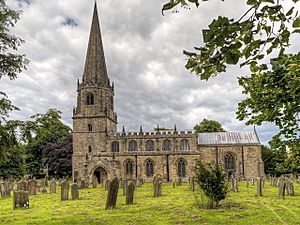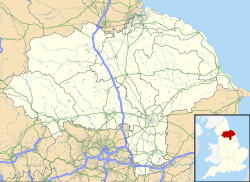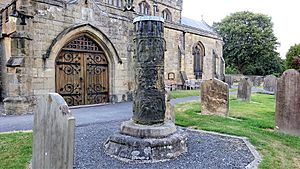Church of St Mary the Virgin, Masham facts for kids
Quick facts for kids Church of St Mary the Virgin, Masham |
|
|---|---|
| St Mary the Virgin, Masham | |

The Church of Saint Mary the Virgin, Masham
|
|
| 54°13′17″N 1°39′13″W / 54.2213°N 1.6537°W | |
| OS grid reference | SE226806 |
| Location | Masham, North Yorkshire |
| Country | England |
| Denomination | Church of England |
| Weekly attendance | 70 (2015) |
| History | |
| Dedication | St Mary the Virgin |
| Architecture | |
| Functional status | Active |
| Architectural type | Perpendicular |
| Specifications | |
| Length | 100 feet (30 m) |
| Width | 51 feet (16 m) |
| Administration | |
| Parish | Masham |
| Benefice | Masham and Healey |
| Deanery | Ripon |
| Archdeaconry | Richmond and Craven |
| Diocese | Leeds |
The Church of St Mary the Virgin, Masham is a historic church in the town of Masham, North Yorkshire, England. It is also known as the Church of St Mary or St Mary's Church. This church stands where an even older Anglo-Saxon place of worship once was. Some of the original Saxon stones are still part of the church today. Experts believe this spot has been used for Christian worship for over 1,400 years.
The church used to have a special court called the Ecclesiastical Court. This court was given to the Diocese of York, but it was too far away for the bishop to visit often. So, a group of 24 local men, known as the Four and Twenty, ran all the court's business. Because they did not send taxes to York, the court became very wealthy. Some people even called it the richest plum in Christendom.
The church is located at the south-east corner of the market square in Masham.
History of the Church
Ancient Beginnings
The Church of St Mary the Virgin is built on the site of a much older Anglo-Saxon church. The Domesday Book mentions a church in Masham. This book was a big survey of England made in 1086. While we don't know exactly where that first church stood, archaeological finds show that people have worshipped here for over 1,400 years. For example, 57 Saxon bodies were found during excavations.
Building Through the Centuries
The current church building started in the 12th century. More parts were added in the 14th, 16th, and 19th centuries. A big restoration happened between 1855 and 1863. This was after lightning struck the church tower in July 1855. During these 19th-century repairs, many carved Anglo-Saxon stones were found hidden in the church walls. More were discovered when the foundations were fixed. The church was given a special Grade II* listing in 1966, meaning it is a very important historic building.
How Masham Got Its Name
Some people believe the town's name, Masham, comes from Mass-Town. This suggests that the church was a central place where people gathered for worship. The church became a special part of York Minster between 1154 and 1181. Because it was so far from York, the local clergy were given the right to manage their own affairs. This special status influenced the name of a famous local beer.
Church Design and Features
The church has several main parts: a vaulted south porch, a nave (the main seating area), a chapel, and a chancel (the area around the altar). It also has two aisles (north and south) and a tower. The church is about 100 feet long and 51 feet wide at its widest point.
Inside, the chancel has a monument to Sir Marmaduke Wyvill, 1st Baronet. The south aisle has many memorials to the Danby family from nearby Swinton. During the Reformation, some church decorations were removed. This included the rood-screen and some stained glass. Most of the church is built in the Perpendicular style. However, some stained glass windows on the south side are in the Decorated style. The font, used for baptisms, is newer. It was given to the church in 1862. It is made of Caen stone and has religious symbols carved into its eight panels.
The Church Tower
The tower is on the west side of the church. Its lower three levels are Norman and were likely built in the 12th century. These levels had openings for bells. In the 14th or 15th century, an octagonal (eight-sided) section was added, with a spire on top. A clock was put on the outside of the spire in 1732. Before that, it was inside the bell tower. The Four and Twenty, who ran the Peculier of Masham, decided the clock face should be outside. They thought it would be "convenient and very useful to the people of the town and those visiting the market."
The Ancient Cross
Just outside the church porch is an ancient stone cross. It is Anglo-Saxon, carved in the 8th or 9th centuries. People believe it was dedicated to St Wilfrid, who was Bishop of Ripon. The cross is about 2.06 meters (6.8 feet) tall and 0.6 meters (2 feet) wide. It used to be called the Paulinus Cross. It has early Christian carvings, though many have worn away over time. Some carvings might have been removed during the Reformation. This cross is similar to others found in churchyards in Wolverhampton and Dewsbury. It was also given a Grade II listing in 1966.
Church in Popular Culture
In January 2017, the church was featured in an episode of the BBC TV series Strike. One of the main characters in the show is from Masham and gets married in the church.
The Peculier of Masham: A Special Court
How the Peculier Began
Roger de Mowbray, the local lord, was captured during the Crusades. He was set free after the Knights Templar paid a ransom for him. To show his thanks, he gave the church to the Church of St Peter in York. However, Masham was very far from York. It was also dangerous for tax collectors to travel there. So, the Archbishop decided that Masham, through its church, could manage its own affairs. The word Peculier comes from an old Norman word meaning particular or special, not strange.
The Four and Twenty
Because of this special right, the Peculier Court of Masham was formed. It had 24 men, known as the Four and Twenty. This group also inspired the name of a famous beer from Theakstons Brewery. The church's leader, called the incumbent, still leads the court. The court used to make decisions on many local matters. These included minor disagreements, following church rules, and making sure children were baptized. They even ruled on things like setting up a school without permission.
Wealth and Influence
Between the 12th and 19th centuries, the court mostly dealt with church matters and Christian customs in Masham and nearby areas. People were fined for not following customs or for not paying into the collection. Others were punished for being Catholic. Since the court did not have to pay taxes to York, it became very rich. Its wealth and power were well-known across northern England. This led to the saying that the Peculier of Masham was the richest plum in Christendom.
Theakston Brewery Connection
When Theakston Brewery started in Masham, their first beer, brewed in 1827, was named Old Peculier. In 1999, the brewery paid for a new stained glass window in the church. This window shows the seal of the Peculier of Masham. This seal, thought to be a picture of Roger de Mowbray, is the same design Theakstons uses for their beer.
The church's incumbent and Theakston Brewery have a contract allowing the use of the Peculier seal on their products. This agreement was last renewed in 1989. As part of the deal, Theakston also paid for a new portrait of the Virgin Mary and the Baby Jesus. This agreement allows the brewery to use the seal until 2040.
See also
- Grade II* listed churches in North Yorkshire (district)
- Listed buildings in Masham



